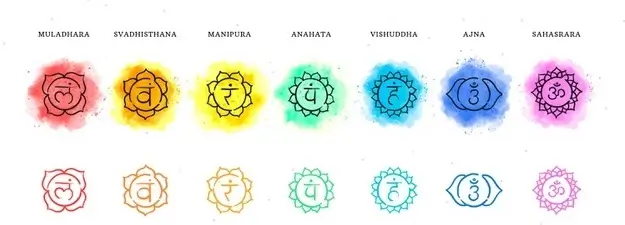
What Are Chakras?

Chakras are energy centers located along the spine, from the base of the body to the top of the head. They play an essential role in the circulation of vital energy, known as prana. When they are harmonized, they promote physical, emotional, and spiritual balance. But when they are blocked or out of balance, tensions, disturbing emotions, or even physical disorders can appear.
1°) The first chakra, called the Root Chakra (Muladhara), is located at the base of the spine. It represents our foundations, our sense of security, and our grounding. When balanced, we feel solid, confident, and capable of moving forward in life. If weakened, anxiety and material instability can take over, creating a constant sense of fear.

2°) A little higher lies the Sacral Chakra (Svadhisthana), in the lower abdomen. It is linked to emotions, sensuality, and creativity. When open, it fosters joy, desire, spontaneity, and the ability to create. But when blocked, it can lead to a lack of vitality, difficulty in experiencing pleasure, or relational blockages.

3°) The Solar Plexus Chakra (Manipura), located in the stomach area, is the center of willpower and self-confidence. It fuels our personal power, our ability to act, and to assert who we are. In balance, it makes us dynamic, confident, and motivated. Out of balance, it can trigger anger, an excessive need for control, or on the contrary, a lack of confidence and self-esteem.

4°) At the center of the chest lies the Heart Chakra (Anahata), the meeting point between body and spirit. It is associated with love, compassion, and relationships. An open heart allows us to give and receive love freely, to nurture sincere bonds, and to experience gratitude. When closed, grudges, fear of suffering, and loneliness often take over.

5°) Higher still, the Throat Chakra (Vishuddha) represents communication and self-expression. It helps us speak our truth, be authentic, and express ourselves freely. When imbalanced, it manifests as difficulties speaking, saying no, or as a tendency toward isolation and enforced silence.

6°) The Third Eye Chakra (Ajna), located between the eyebrows, is considered the seat of intuition and inner wisdom. When balanced, it paves the way for greater clarity of mind, deep inner vision, and strong intuition. But when blocked, it can lead to confusion, illusions, or difficulty trusting one’s own instincts.

7°) Finally, at the top of the head is the Crown Chakra (Sahasrara), which connects us to the spiritual dimension and universal consciousness. It is the center of connection with something greater than ourselves, whether we call it the soul, the universe, or the divine. An open Crown Chakra fosters inner peace, wisdom, and a deep sense of unity. When closed, it can lead to a feeling of emptiness, loss of meaning, or spiritual disconnection.

✨ Chakras are therefore much more than a mystical concept: they form a true map of our inner being. Taking care of them—through meditation, yoga, breathing, mantras, or crystals—restores a smooth circulation of energy and helps us regain lasting balance in life.

How to Work on Your Chakras?
Working on your chakras means learning to rebalance and harmonize the energy that flows within us. It’s not only a spiritual practice: it’s also a path of self-awareness, emotional release, and inner alignment.
The first step is to become aware of your chakras. Each one corresponds to a specific area of life: security, emotions, confidence, love, communication, intuition, and spirituality. Observing where you feel imbalance in your life is already the first step toward harmonization.
Meditation is one of the most powerful practices for rebalancing the chakras. Visualizing each energy center as a wheel of light, associating it with its color (red for the root chakra, orange for the sacral, yellow for the solar plexus, green for the heart, blue for the throat, indigo for the third eye, and violet for the crown), then breathing deeply while imagining this light intensifying, helps purify and reactivate the energy flow.
Yoga is also a valuable tool. Each posture acts on one or several chakras. Grounding poses strengthen the root chakra, hip-opening poses stimulate the sacral, twists energize the solar plexus, and heart-opening postures (such as bridge or camel) help release Anahata.
Sounds and mantras are also used to harmonize the chakras. Each energy center has a particular vibrational sound: for example, LAM for the root chakra, VAM for the sacral, RAM for the solar plexus, and so on. Repeating these mantras during meditation activates their frequency.
You can also work on your chakras with crystals and natural stones. Garnet or red jasper strengthen the root chakra, carnelian stimulates the sacral, citrine activates the solar plexus, rose quartz or emerald balance the heart, sodalite supports the throat, amethyst opens the third eye, and clear quartz purifies the crown.
